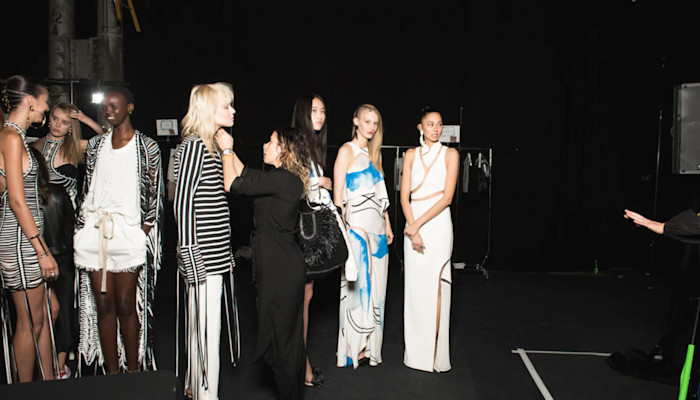Online fashion weeks
How online platforms made PJs acceptable attire for catwalk spectators
In December 2020, the annual Melbourne Fashion Festival moved to a hybrid delivery with both in-person and online events. While this was due to the impact of COVID-19, it seemed an overdue decision to make these events more accessible. Clothes are, after all, worn by all of us — with the exception of nudists — so why shouldn’t we all have access to view the latest local collections and support our local designers?
Melbourne Fashion Festival isn’t just a high fashion event. They have graduate runways, casual and everyday collections from local brands, as well as the couture shows. As someone who loves fashion but feels rather intimidated by the high-flying Devil Wears Prada and Sex and The City types who attend these events, I was glad to have my first opportunity to watch runways from the comfort of my home, in my pyjamas, where I felt comfortable.
Watch the Melbourne Fashion Festival Runway shot in the Royal Botanic Gardens here.

The online fashion week trend started with Shanghai Fashion Week in March 2020. The event reeled in 500 million yuan (approximately $102m AUD) and had a total of 11 million livestream views. Following China’s lead, Moscow and Mexico City then hosted online fashion events in April, followed by The British Fashion Council adopting an online format for their men’s fashion week in June. The digital three-day ‘week’ included a range of online media for viewers to consume, including podcasts and photo diaries to replace in-person events.
The big players such as Paris, Milan and Copenhagen then followed suit with elite fashion houses such as Dior opting for collection preview films instead of catwalks during lockdown. What would normally be an exclusive event in Paris turned into an open-access event for the world to witness. All you needed was an internet connection and a screen, and you could take part in the most elite event on the fashion calendar — Paris Fashion Week. As Louis Vuitton designer Nicolas Ghesquière recently said in his own Women’s Fall-Winter 2021 collection preview film, “wherever you may be in the world, I hope that you will enjoy the show from home”, welcome people from all walks of life to view his collection. With over two million views on YouTube at the time of writing, it seems people did just that. For the first time, people all over the world could now attend a year’s worth of fashion events for less than it would cost them to subscribe to their local edition of Vogue.
Watch the Dior Autumn-Winter 2020-2021 film here.

Fortunately for Melbourne, we were in a position earlier this year where we could enjoy live events — albeit with social distancing and COVID-safe measures in place. But the Melbourne Fashion Festival organisers decided to keep online events as well. As a festival which celebrates ideas as well as design, the Melbourne Fashion Festival also presented the Australian Fashion Summit: ‘ a series of online discussion designed to drive critical discussion around the issues facing the future of fashion in Australia’. These events, which featured talks from industry professionals around the world, remained accessible online and were pre-recorded so viewers could watch them at their leisure.
For the first time, you didn’t need to be a fashion executive to attend talks on the future of the circular economy or Indigenous representation; you didn’t need to be in the front row to see all the intricate details in the Paolo Sebastian and Maticevski couture collections. Even now in May 2021, several months after the official fashion ‘week’ has ended, runways are still freely available on the festival website, along with ticketed panel discussions from the Australian Fashion Summit.
Fashion weeks have historically been supported by international editors, buyers, advertisers and sponsors. Mercedes-Benz alone supported 70 annual fashion events across 40 countries before the advent of COVID-19. However, in some cases, the cancelling of events has caused the smaller fashion weeks to join forces and find strength in numbers. Senegalese designer and creator of Dakar Fashion Week and Fashion Africa TV, Adama Ndiaye, has been working towards various coordinated fashion events across the African continent for years. COVID-19 was the catalyst to make her vision a reality. During the lockdowns in 2020, Ndiaye organised a series of online fashion shows featuring models in their own homes. From Dakar in Senegal to Abidjan in Ivory Coast and Bamako in Mali, models wore the latest designs from local fashion houses for viewers to watch from their homes.
So where will fashion weeks go from here? From an industry perspective, Ida Petersson (Buying Director for Browns) is hoping for the continuation of both online and in-person events so buyers “don’t travel to the level that [they] did before,” both for personal wellbeing and environmental wellbeing. As an industry that intersects with business and culture, Petersson also emphasises the ongoing importance of fashion weeks as “a cultural exchange as much [as] a business exchange”. She says, “I think [cultural exchange is] the wonderful part of what the fashion world is” and without it, the whole industry becomes “a bit less colourful”. Online fashion weeks help break down traditional hierarchies in the annual event calendar and enable this global exchange of style and ideas.
At the end of the day, sometimes it’s just nice to know that I can be sitting in my pjs eating ice cream after midnight, watching the same runway shows as the Editor-in-Chief of Vogue Australia.
Cover image by Flaunter via Unsplash.
